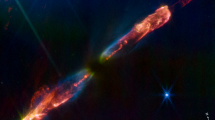Abstract
By mapping the12COJ = 1—0 lines in IRAS 05391-0217, 06114 + 1745 and 06291 + 0421, three new high-velocity bipolar molecular outflows are found. Parameters of these outflows are derived, which suggest that they are massive and energetic outflows with total kinetic energies of about 1038 J and mass loss rates about 10-5 M/a. The driving sources are identified by analyzing the positions, intensities and color temperatures of the associated infrared sources. These outflows are most likely driven by single sources which correspond to massive young stellar objects. In these regions H2O masers have been detected located near the embedded infrared sources, which indicates that their exciting mechanism may be correlated with that of the CO outflows. The relationship between the parameters of outflows and central sources shows that high-velocity outflow and thermal radiation of a star are two basic correlated but different features in the evolution of young stars.
Similar content being viewed by others
References
Zukerman, F., Kwiper, E., Rodrigues, K. E., High velocity gas in the orion infrared nebula,Ap. J., 1976, 209: L137.
Bally, J., Lada, C. J., The high velocity molecular flows near young stellar objects,Ap. J., 1983, 265: 824.
Snell, R. L., Loren, R., Planbeck, R., Observations of CO in L1551: Evidence for stellar wind driven shocks,Ap. J., 1980, 239: L17.
Goldsmith, P. F., Snell, R. L., Heyer, M., Bipolar koutflows in dark clouds,Ap. J., 1984, 286: 599.
Fukui, Y., inProc. ESO Workshop on Low Mass Star Formation and Pre-main Sequence Objects (eds. Reipurth, B.), ESO, Garching bei München, 1989, 95.
Wu, Y., Huang, M., He, J., A Catalogue of high velocity molecular outflows,A&AS, 1996: 115: 283.
Shepherd, D. S., Churchwell, E., High velocity molecular gas from high mass star formation regions,Ap. J., 1996, 457: 267.
Lada, C. J., Cold outflows, energetic winds, and enigmatic jets around young stellar objects,Arm. Rev. A&A, 1985, 23:267.
Wouterloot, J. G. A., Brand, J., IRAS sources beyond the solar circle, I. CO observations,A&AS, 1989, 80: 149.
Snell, R. L., Scoville, N. Z., Sanders, D. B. et al., High-velocity molecular jets,Ap. J., 1984, 284, 176.
Casoli, F., Dapraz, C., Gerin, M. et al.,13CO and12CO observations of cold IRAS unidentified point sources in the Galaxy,A&A, 1986, 169: 281.
Xiang, D., Turner, B. E., Newly discovered galactic H2O masers associated with outflows,Ap. JS, 1995, 99: 121.
Wouterloot, G. A., Brand, J., Henkel, C., Star formation in the outer Galaxy,A&A, 1987, 191: 323.
Palla, F., Brand, J., Cesaroni, R. et al., Water masers associated with dense molecular clouds and ultracompact HII regions,A&A, 1991, 246: 249.
Cabrit, S., Bertout, C., CO line formation in bipolar flows III. The energetics of molecular flows and ionized winds,A&A, 1992, 261: 274.
Author information
Authors and Affiliations
Additional information
Project supported by the National Natural Science Foundation of China (Grant No. 19773002) and the United Radio Astronomy Lab. of Chinese Academy of Sciences.
Rights and permissions
About this article
Cite this article
Wu, Y., Yang, C., Li, Y. et al. High-velocity molecular outflows hear massive young stellar objects. Sci. China Ser. A-Math. 42, 732–738 (1999). https://doi.org/10.1007/BF02878992
Received:
Issue Date:
DOI: https://doi.org/10.1007/BF02878992




